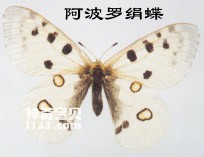This species is a precious large silk butterfly that has long been extinct in Poland and Spain. Therefore, it was the first insect to be included in the Convention on International Trade in Endangered Species of Wild Fauna and Flora and was listed as a Level II protected species. It is listed as II protected object in my country's "List of National Key Protected Wild Animals". The IUCN Red Book "Threatened World Papilio Butterfly" lists it as R-rated (very few individuals). Many countries and regions have adopted corresponding and effective protection measures, including designating habitats as protected areas, assisted breeding, reintroduction, afforestation, setting up special parks for protection, etc.

Wingspan is 79~92mm. Wings white or yellowish white. translucent. There are large black spots in the middle and end of the middle chamber of the forewing, 2 black spots on the outer side of the middle chamber, the outer edge is dark brown, there are irregular dark brown bands on the sub-outer edge, and there is 1 black spot in the middle of the trailing edge. The base of the hind wings and the base half of the inner edge are black; there is one red spot each on the front edge and the middle part of the wing, sometimes with a white center and a black border around it; there are 2 red spots or 1 red and 1 black spot on the hip corner and inner side, with a black border around it. Black border; submarginal black band breaks into 6 black spots. The reverse side of the wings is similar to the front side, but there are 4 red spots with black edges on the base of the wings, and the 2 hip spots are also red spots with black edges. The female butterfly is darker in color, with the outer translucent band and submarginal black band on the forewings wider and more obvious than the male butterfly, and the red spots on the hind wings are larger and brighter than the male butterfly.
The eggs are flat and have many granular micro-protrusions on the surface, arranged regularly. The area around the fine hole is slightly concave, and the tiny particles here are significantly smaller than in other parts. The eggs are grayish white, with light yellowish green around the spermaper. The diameter is about 1.38mm and the height is about 0.85mm.
The head of the first instar larvae is dark brown and shiny, with black hairs growing on it. The stink horn is not obvious. The pronotum is dark brown and shiny. The body is dark brown, slightly lighter underneath. The front half of the chest is orange-yellow. The supra-anal plate is chitinized, dark brown. The body of the final instar larvae is black, and the round spots from the prothorax to the subdorsal line of the 9th abdominal segment are red.
The body of the pupa is dark brown and shiny, covered with off-white powder. The head is round and without protrusions. The valve in the anterior chest is closed. Medium chest round. The protrusions at the base of the forewings are obtuse. The abdomen is oval when viewed from the back and curves toward the ventrally when viewed from the side. There is a shallow depression on the upper line of each abdominal throttle. Body length is about 21mm.
Host: Sedum spp.
Biology: One generation per year, overwintering with eggs. Adults emerge in August and live in subalpine areas between 750 and 2000m.
Distribution: Xinjiang; European countries, Türkiye, Mongolia.
Reasons for endangerment: excessive collection and trade, acid rain, urbanization, agriculture, and deforestation.
Conservation significance: The remnant species of the Ice Age are of great significance to the study of the phylogeny evolution and historical biogeography of Papilio butterflies; they are available for viewing and are a rare species in the world.
The Apollo silk butterfly (Parnassius apollo) is perhaps the best-known geographically variable species in Europe. This attractive butterfly inhabits hillsides and mountain grasslands throughout Europe and parts of Asia. It forms a large number of different local populations isolated in different mountainous areas or mountain ranges. The main range of variation is the intensity of the black streaks and the size and number of red spots.
animal tags:
We created this article in conjunction with AI technology, then made sure it was fact-checked and edited by a Animals Top editor.